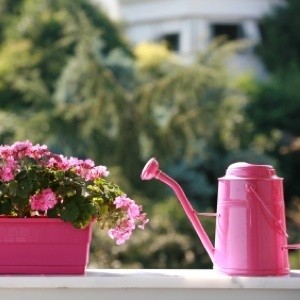
Plants growing in containers are much more susceptible to damage from too much or too little moisture than those growing in the ground. They should never be allowed to dry out completely, but neither should their growing medium ever be allowed to become waterlogged. Keeping moisture levels consistent for container plants requires that you constantly watch and respond to current conditions. Here are some tips to make the job easier.
Like people, plants are individuals, each with their own distinctive needs. When and how much water they need depends on several factors. Rather than adopting a universal watering routine, it's best to supply individual plants with water as they need it.
Factors affecting a plant's water needs:
The best way to test the moisture level in your soil mix is to insert your finger one inch beneath the surface. If the soil feels moderately moist, it's likely that the plant's roots have access to adequate moisture. If the soil feels dry, it's time to water.
Prevention is the best cure to avoiding waterlogged plants. Make sure containers have sufficient drainage holes and empty water from drip trays so the plant's roots are not standing in water. If several days of heavy rains are in the forecast, consider relocating plants under overhangs or large trees. If soil becomes overly wet, moving them to a sunny, breezy spot with help them dry out.
Frequent watering is a necessary chore when growing plants in containers because moisture in the soil evaporates quickly. Here are some tips and tricks for retaining moisture and reducing the amount of time you need to spend watering.
Pre-soak clay pots: Submerge terra cotta pots in a pail of water before planting. This helps prevent the clay from drawing water out of the soil mix and keeps the soil moist longer.
Line pots with bubble wrap: Containers made from porous materials like terra cotta dry out the fastest. Lining the inside with bubble wrap before planting will decrease water loss through evaporation, as well as insulating the plant's roots against extreme fluctuations in temperature.
Leave a soil gap: Leave a 1 inch gap between the surface of the soil and the rim of the container. When it rains, the gap will give water enough time to penetrate the soil and reach the roots before running over the sides.
Use moisture-retaining potting soil: Commercial grade soil mixes are now available containing special moisture-retaining granules. The granules are designed to absorb moisture when watered and slowly release it back into the soil as it dries out.
Mulch the surface: Add a layer of mulch over moist soil to slow down evaporation and help conserve water. For a decorative touch use stones, shells, aquarium gravel, or marbles.

About The Author: Ellen Brown is an environmental writer and photographer and the owner of Sustainable Media, an environmental media company that specializes in helping businesses and organizations promote eco-friendly products and services.
Add your voice! Click below to comment. ThriftyFun is powered by your wisdom!
Add your voice! Click below to comment. ThriftyFun is powered by your wisdom!